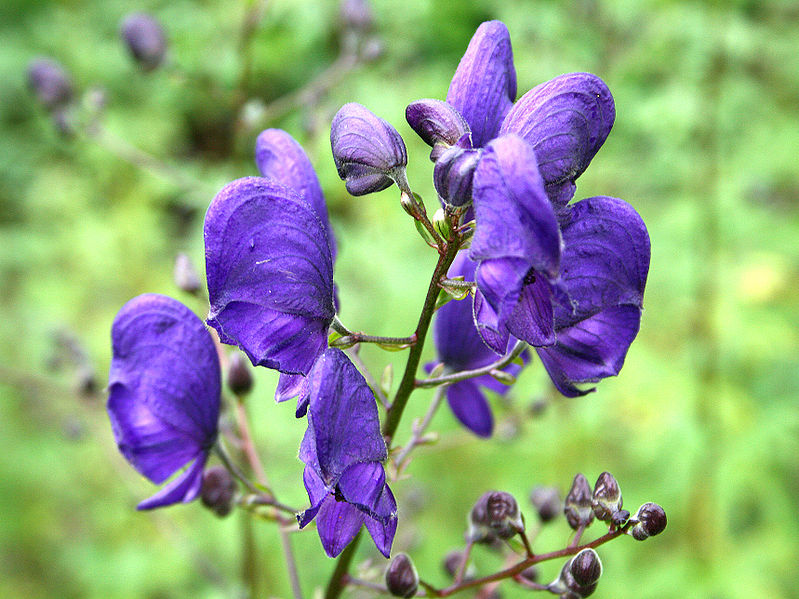Aconite Biological Sources, Morphology, Chemical Constituents, Adulterants and Uses + MCQ (10)
Aconite
Synonyms :-
Monkshood, Friar’s cowl; Mouse-bane; Aconite root; Mit-zahar (Hindi); Radix aconiti.
Biological Source :-
Aconite is the dried roots of Aconitum napellus Linn, collected from wild or cultivated plants., belonging to family Ranunculaceae.

Geographical Source :-
The plant has been originated from the mountaneous and temperate regions of Europe, It occurs in Alps and Carpathian mountains, hills of Germany and Himalayas. The greater part of the commercial drug is derived from wild plant grown in central and southern Europe, particularly Spain.
Cultivation and Collection :-
- Aconite is a perennial herb with a fusiform tuberous root.
- The plant is propagated from the daughter tubers. An apical bud on the apex and six lateral buds on its surface are developed.
- A lateral shoot bearing a thin lateral root is produced from each lateral bud. The lateral roots are called daughter roots and the main root is known as parent root.
- The daughter root develops gradually, becomes thick in autumn and buds are produced on its apex and surface.
- Daughter roots are pianted in soil containing leaf mould and some amount of lime.
- The roots are collected in autumn. Collection of Aconite from wild plants is done during flowering season.
- Roots are dried at 40–50°C. Thus Aconite arises from one or more lateral shoots which develop into conical daughter tubers.
Morphology :-
- Appearance of Aconite varies from season to season. Aconite collected in autumn is conical in shape and tapering below. Surface is slightly twisted bearing longitudinal ridges.
- Some Aconites may contain fibrous rootlets or their scars. On the top of parent root some remains of stem base are present which are more shrivelled. An apical bud is present at the apex.
- The colour is dark-brown.
- The root is 4–10 cm in length and 1–3 cm in diameter at the crown. Rootlets may be present. The fracture is short and starchy.
- The fractured surface is five to eight angled, contains stellate cambium and a central pith.
- The odour is slight.
- Taste is sweet at first followed by tingling and numbness.
Chemical Constituents :-
- Aconite contains aconitine (0.4–0.8%), hypaconitine, mesa-conitine, aconine, napelline (isoaconitine, pseudoaconi-tine), neoline, ephedrine, sparteine, picraconitine, acotinic acid, itaconic acid, succinic acid, malonic acid, fat, starch, aconosine, 14-acetyineoline, hokbusine A, senbusines A and C and mesaconitine.
- The aconitines are diacyl esters of polyhydric amino alcohols and are extremely poisonous.
- The basic skeleton of aconite alkaloid is consisted of a pentacyclic diterpene.
Uses :-
- It is used externally as a local analgesic in liniments and to treat neuralgia, rheumatism and inflammation.
- Tincture Aconite is antipyretic in small doses.
- Aconitine in amount 2–3 mg can lead respiratory failure, heart failure and in the end death.
- The drug is used for the preparation of an antineuralgic liniment.
MCQ
1. Aconite belong to family
A. Combretaceae
B. Liliaceae
C. Solanaceae
D. Ranunculaceae
2. Which of the following is synonymous of Aconite?
A.caryophyllus
B. Quince
C. Mit-zahar
D. Ginger
3.Which of the following is not use of Aconite ?
A. antipyretic
B. Anti cancer
C.Inflammation
D. local analgesic
4. How many mg is aconite is toxic ?
A. 2-3 mg
B. 4-6 mg
C. 7-8 mg
D. 9-10 mg
5.Which of the following is false sentence about Aconite ?
A.Aconite contains aconitine.
B.Aconite is the dried roots of Aconitum napellus Linn, collected from wild or cultivated plants.
C. Aconite is mainly cultivated in South India.
D. Aconite is a perennial herb with a fusiform tuberous root.
6. Which of the following is false morphology characteristics of aconite ?
A. The root is 4–10 cm in length and 1–3 cm in diameter at the crown.
B. Aconite has bark brown.
C. Aconite has sweet taste.
D. Aconite has Red brown bark.
7.Which of the following is major chemical constituents of Aconite ?
A. Aconitine
B. Acotinic acid
C. Neoline
D. Alcohol
8. Which of the following is not synonym of aconite ?
A.Mouse-bane
B. Spider posion
C.Mit-zahar
D. Monkshood
9. Aconite is
A. Biennial
B. Annual
C. Perennial herb
D. None of the above
10. How many cm length of root of aconite ?
A. 1-5 cm
B. 4-10 cm
C. 6-8 cm
D. 3-8 cm
List of Successful GPATINDIAN CANDIDATES
Participate in Online FREE GPAT TEST: CLICK HERE
Participate in Online FREE Pharmacist TEST: CLICK HERE
Participate in Online FREE Drug Inspector TEST: CLICK HERE
Participate in CSIR NET JRF Mock Test
Answer Key
1. D
2. C
3. B
4. A
5. C
6. D
7. A
8. B
9. C
10. B
Reference :-
16 Edition of Trease and Evans Pharmacognosy Text Book ( Pg. No. :- 412)
https://www.tandfonline.com/doi/full/10.1080/15563650902904407?scroll=top&needAccess=true